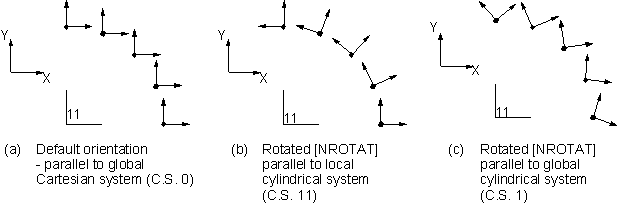While global and local coordinate systems locate geometry items, the nodal coordinate system orients the degree of freedom directions at each node. Each node has its own nodal coordinate system, which, by default, is parallel to global Cartesian (regardless of the active coordinate system in which the node was defined). You can rotate the nodal coordinate system at any node to a desired orientation using one of the following methods:
Rotate the nodal coordinate system into the active coordinate system with the NROTAT command. That is, the nodal X-axis is rotated to be parallel to the X or R axis of the active system, the nodal Y-axis is rotated to be parallel to the Y or θ axis of the active system, and the nodal Z-axis is rotated to be parallel to the Z or Φ axis of the active system.
Rotate the nodal coordinate system by known rotation angles. (Since you will usually not know these rotation angles explicitly, you will probably find the NROTAT method to be more useful.) You can define the rotation angles at the time the node is created with the N command, or you can specify rotation angles for existing nodes with the NMODIF command.
Rotate the nodal coordinate system by direction cosine components with the NANG command.
Rotate the nodal coordinate system to surface normal with the NORA command.
You can list the nodal coordinate rotation angles with respect to the global Cartesian system by using the NLIST command.
Input data that are interpreted in the nodal coordinate system include component values of the following:
Degree of freedom constraints
Forces
Master DOF
Coupled nodes
Constraint equations
The following results data are reported in the nodal coordinate system on the output file and in POST26:
Degree of freedom solution
Nodal loads
Reaction loads
In POST1, results data are reported in terms of the results coordinate system (RSYS), not the nodal coordinate system.



